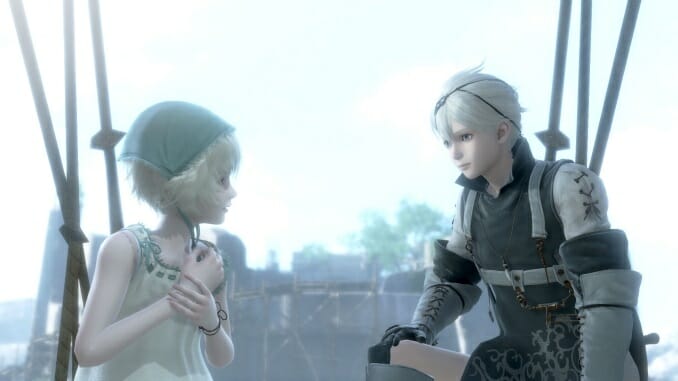Nier Replicant Refuses to Compromise, for Better and Worse

Over the last two decades, Yoko Taro has become one of gaming’s most elusive developers. Notably camera shy, he usually appears on-screen in his signature mask rolling on the floor with merch or cracking jokes and generally dodging answers in interviews. Beyond that, his work is known for its singularity—they’re particularly dark while maintaining a morbid humor, gleefully fuse together multiple genres that pique Taro’s interests, and, until Nier: Automata, were known as nearly unplayable. Back in the day, new fans of Taro’s work would be directed to Let’s Plays of Drakengard, under the belief that they’d more likely enjoy their time with Taro’s game if divorced from having to play it themselves.
Taro’s work is thematically just as alienating, and intentionally so; Drakengard is grim to the point of hyperbole, and its connections to the Nier universe are tenuous and esoteric. Drakengard is the kind of series that could never achieve mainstream popularity. It’s dark, but not in the conventional God of War sort of way, and its storytelling is a jumbled, fragmented mess of incest, pedarasty, and cannibalism (all truncated with rhythm games and Panzer Dragoon-esque segments).
Taro managed to achieve a cult following for his work on 2010’s Nier, a game that, like Drakengard, was not destined for mainstream success at the time. Nevertheless, Square Enix attempted for international success—the gameplay was pointedly made into a marketable action-style roleplaying game, and for its Western release, the game featured a burly older main character as opposed to the younger slim character in the game’s original incarnation. Westerners respond more to father-daughter relationships in their games than sibling ones, apparently. Despite these measures, the game was unable to find traction to make it as much of a rousing success as its sequel, Nier: Automata, later became. The game’s shoestring budget was glaring, with choppy visuals, ill-conceived side quests, and shallow gameplay.
Through all the setbacks, Nier’s idiosyncrasies managed to shine and foster a dedicated fanbase. The game popularly became known as a “good story, bad gameplay” game, politely leaving the conversation until Automata’s surprise success in 2017. PlatinumGames’ high octane style managed to give Nier the electric jolt it needed to appeal to a wide audience, Trojan Horse-ing its bizarre storytelling style and philosophical dilemmas with flashy beat-em-up sequences and sumptuous art design. Nier composer Keiichi Okabe’s score gives the game an elegiac, mysterious tone, and rang all the more unique for the next generation of gamers that missed out on the original.

This is all preface to an interesting quandary: what does it look like to remake a game like Nier? How do we reintroduce a game whose seeming failure is almost intrinsic to its legacy? Nier has mythologized itself over the years, thanks in part to its creation myth-esque relationship to Automata, which takes place thousands of years after Nier’s Ending D. Its cryptic storytelling and imperceptible sadness is fascinating and seemingly impenetrable, and conversations over the game’s intentionality versus accidental genius have stirred since the game’s release. Nier is nothing if not a unique game with a scrappy spirit.
Nier Replicant ver1.22474487139… is, in many ways, the perfect reintroduction to a videogame. With revamped visual design that rivals Automata, the game’s setting is a stunning world of shock and awe worth getting lost in. The combat system has been lightly retouched, still echoing Nier’s unique identity when compared to Automata’s 2B but feeling more weighty and purposeful than hollow and repetitive. But does all this necessarily make ver1.22.. the “definitive” Nier experience?
-

-

-

-

-

-

-

-

-

-

-

-

-

-

-

-

-

-

-

-

-

-

-

-

-

-

-

-

-

-

-

-

-

-

-

-

-

-

-

-









































